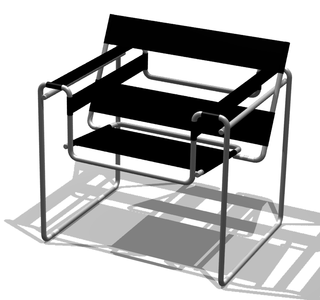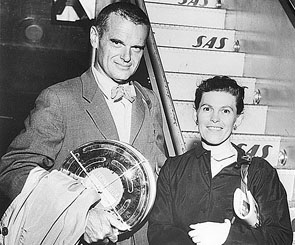
The Eames House is a landmark of mid-20th century modern architecture located at 203 North Chautauqua Boulevard in the Pacific Palisades neighborhood of Los Angeles. It was constructed in 1949, by husband-and-wife design pioneers Charles and Ray Eames, to serve as their home and studio. The house was commissioned by Arts & Architecture mags as part of its Case Study House program, challenging architects to design progressive, but modest, homes in Southern California. Charles and Ray moved into the home on Christmas Eve in 1949 and never moved out. Charles's daughter, Lucia Eames, inherited the home and created the non-profit organization, the Eames Foundation, in 2004. Still a historic house museum maintained by the Eames Foundation, it was designated a National Historic Landmark in 2006 and serves as a pilgrimage site for nearly 20,000 visitors a year.

George Nelson was an American industrial designer. While lead designer for the Herman Miller furniture company, Nelson and his design studio, George Nelson Associates, designed 20th-century modernist furniture. He is considered a founder of American modernist design.
MillerKnoll, Inc., doing business as Herman Miller, is an American company that produces office furniture, equipment, and home furnishings. Its best known designs include the Aeron chair, Noguchi table, Marshmallow sofa, Mirra chair, and the Eames Lounge Chair. Herman Miller is also credited with the 1968 invention of the office cubicle under then-director of research Robert Propst.

Modern furniture refers to furniture produced from the late 19th century through the present that is influenced by modernism. Post-World War II ideals of cutting excess, commodification, and practicality of materials in design heavily influenced the aesthetic of the furniture. It was a tremendous departure from all furniture design that had gone before it. There was an opposition to the decorative arts, which included Art Nouveau, Neoclassical, and Victorian styles. Dark or gilded carved wood and richly patterned fabrics gave way to the glittering simplicity and geometry of polished metal. The forms of furniture evolved from visually heavy to visually light. This shift from decorative to minimalist principles of design can be attributed to the introduction of new technology, changes in philosophy, and the influences of the principles of architecture. As Philip Johnson, the founder of the Department of Architecture and Design at the Museum of Modern Art articulates:
"Today industrial design is functionally motivated and follows the same principles as modern architecture: machine-like simplicity, smoothness of surface, avoidance of ornament ... It is perhaps the most fundamental contrast between the two periods of design that in 1900 the Decorative Arts possessed ..."

Vitra is a Swiss family-owned furniture company with headquarters in Birsfelden, Switzerland. It is the manufacturer of the works of many furniture designers. Vitra is also known for the works of notable architects that make up its premises in Weil am Rhein, Germany, in particular the Vitra Design Museum.

Alexander Girard, affectionately known as Sandro, was an architect, interior designer, furniture designer, industrial designer, and a textile designer.

Knoll is an American company that manufactures office systems, seating, storage systems, tables, desks, textiles, as well as accessories for the home, office, and higher education. The company is the licensed manufacturer of furniture designed by notable architects and designers such as David Adjaye, Harry Bertoia, Ludwig Mies van der Rohe, Florence Knoll, Frank Gehry, Charles Gwathmey, Maya Lin, Marc Newson, Ini Archibong, Eero Saarinen, and Lella and Massimo Vignelli, under the company's KnollStudio division. Over 40 Knoll designs can be found in the permanent design collection of the Museum of Modern Art in New York City.

The Eames Lounge Chair Wood (LCW) is a low seated easy chair designed by husband and wife team Charles and Ray Eames.

Charles Ormond Eames Jr. was an American designer, architect and filmmaker. In professional partnership with his spouse Ray Kaiser Eames, he was responsible for groundbreaking contributions in the field of architecture, furniture design, industrial design, manufacturing and the photographic arts.

Bernice Alexandra Kaiser Eames was an American artist and designer who worked in a variety of media.

Charles Eames and Ray Eames were an American married couple of industrial designers who made significant historical contributions to the development of modern architecture and furniture through the work of the Eames Office. They also worked in the fields of industrial and graphic design, fine art, and film. Charles was the public face of the Eames Office, but Ray and Charles worked together as creative partners and employed a diverse creative staff. Among their most recognized designs is the Eames Lounge Chair and the Eames Dining Chair.

Organic Abstraction is an artistic style characterized by "the use of rounded or wavy abstract forms based on what one finds in nature." It takes its cues from rhythmic forms found in nature, both small scale, as in the structures of small-growth leaves and stems, and grand, as in the shapes of the universe that are revealed by astronomy and physics. Nautillus shells and honeycombs are examples of organic structures that have served as inspiration for this work, along with the bones and musculature of the body, both human and animal.

The Eames Aluminum Group series is a line of furniture designed by the office of Charles and Ray Eames for Herman Miller in 1958. It is an icon of office furniture and a "high-status symbol of modern design".

Grete Juel Jalk (1920–2006) was a Danish furniture designer. From the 1960s, she did much to enhance Denmark's reputation for modern furniture design with her clear, comfortable lines. She also edited the Danish magazine Mobilia and compiled a four-volume work on Danish furniture.

Rolf Fehlbaum is chairman emeritus and active member of the board of directors of Vitra, a family-owned furniture company with headquarters in Birsfelden, Switzerland.
Don Charles Albinson was an American industrial designer who made many contributions to the world of furniture. He worked with Charles and Ray Eames for 13 years, helping develop many of the seminal Herman Miller furniture pieces from the mid century – the bent plywood chair, the fiberglass shell chair, the aluminum group set, and the Eames Lounge chair, to name a few. He later developed the Knoll Stack chair, the Westinghouse office line, an update to the DoMore Series 7 landscape system named Neo 7, the Albi stack chair for Fixtures, and the Bounce chair for Stylex.
Hume Modern is an American furniture restoration specialist. It is known for preserving items by Charles and Ray Eames, Florence Knoll, Eero Saarinen and other manufacturers of the American and European mid-century modern period. The company received plaudits in the wake of Hurricane Sandy for restoring items damaged by the New York/New Jersey seaboard. Hume Modern also restores pieces by Harry Bertoia, Warren Platner, George Nelson, Richard Schultz, Marcel Breuer, Frank Gehry, Mies van der Rohe and Herman Miller.
Peter Jon Pearce is an American product designer, author, and inventor.

The Eames Molded Plastic & Fiberglass Armchair is a fiberglass chair, designed by Charles and Ray Eames, that appeared on the market in 1950. The chair was intentionally designed for the International Competition for Low-Cost Furniture Design. This competition, sponsored by the Museum of Modern Art, was motivated by the urgent need in the post-war period for low-cost housing and furnishing designs adaptable to small housing units.

Molded plywood is the term for two- or three-dimensionally shaped products from multiple veneer layers that are glued together through heat and pressure in a pressing tool. The veneer layers are arranged crosswise at an angle of 90 degrees. Molded wood is used for flat furniture components such as seats, backrests and seat shells. When the veneer layers are arranged in the same direction, it is called laminated wood. It is used for armrests and chair frames. After pressing, the blanks are processed mechanically. A particular feature is the ability to produce different variations of shapes from the blanks. Due to its immense strength and low weight, molded wood is particularly suitable for interior decoration, seating furniture, bed slats, skateboards and vehicle construction.

















